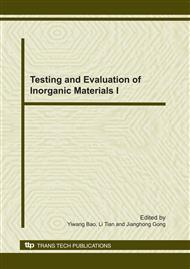p.148
p.151
p.154
p.157
p.161
p.165
p.170
p.173
p.178
Finite-Element Simulations of Residual Stresses Developed in Ti3AlC2 Diffusion Bonds with a Si Interlayer
Abstract:
The distributions of the residual stress in Ti3AlC2/Si/Ti3AlC2 diffusion bonded joints were studied using finite element method (FEM) considering the properties of reaction product. The effect of thickness of reaction layer on the residual stress was also investigated. The results indicate that the gradients of the residual stress are great near the joint edge. The maximal residual stress produces at the reaction layer adjacent to the interface of the Ti3Al(Si)C2 solid solution and Ti3AlC2, which can have a great effect on joint strength. With the increase of reaction layer thickness, the magnitudes of the residual stress decrease.
Info:
Periodical:
Pages:
161-164
Citation:
Online since:
December 2010
Keywords:
Price:
Сopyright:
© 2011 Trans Tech Publications Ltd. All Rights Reserved
Share:
Citation:


